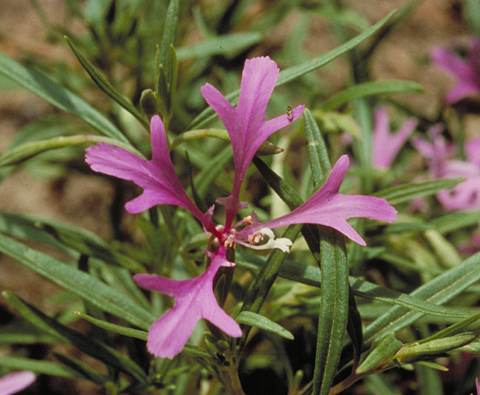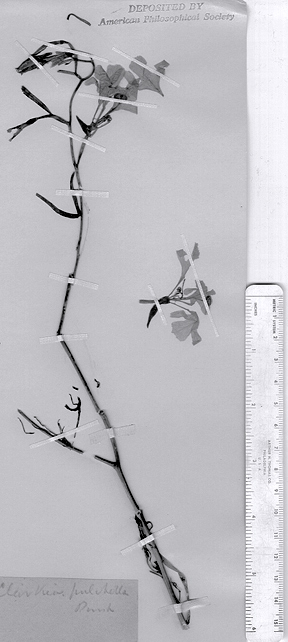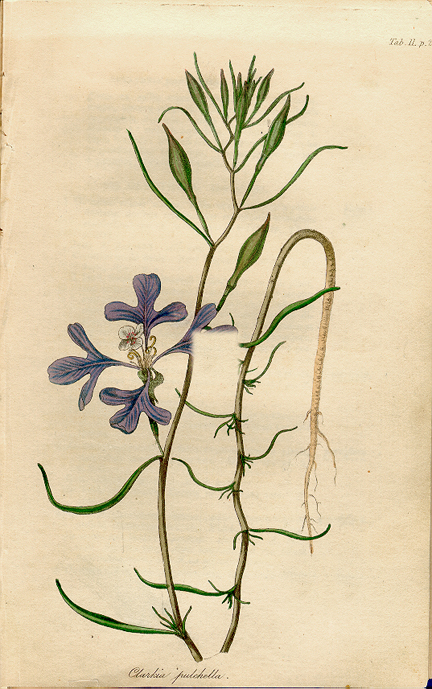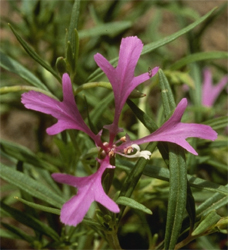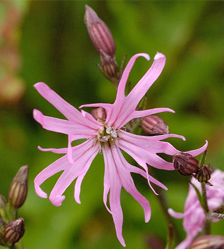Named for William Clark
On their return journey in 1806, the Corps of Discovery had to camp for nearly a month (14 May 1806 to 10 June 1806) in the vicinity of present-day Kamiah (pronounced KAM-ee-eye), Idaho, to wait for the snow to melt in the Bitterroot Mountains. Lewis used this time to study and describe many of the plant specimens he had collected. The flower pictured here is one of those, and his description of it is among his most detailed, running to nearly 500 words.
In some localities the plant’s most common name today is ragged robin, but it is also known as pink fairy and deerhorn. In the spring of 1807 Lewis turned over his plant specimens to the young German-American botanist, Frederick Pursh, who gave this flower the scientific name Clarkia pulchella, in honor of William Clark; pulchella means beautiful. Appropriately, the best of its common names today is clarkia.
Seven different species of this lovely flower are found between British Columbia and southern Oregon, and eastward to South Dakota. Only two of them grow in the Rocky Mountains.
It is not known exactly how many specimens of plants Lewis and Clark collected. Those that were acquired between Fort Mandan and the Great Falls of the Missouri were cached underground at White Bear Islands—the upper portage camp—and were destroyed by springtime floodwaters before Lewis returned on July 13, 1806. All but one of the specimens Lewis gathered on the upper Missouri, Jefferson, and Beaverhead rivers, as well as in the vicinity of Lemhi Pass, which were cached at Camp Fortunate, were similarly destroyed. The only one of the latter that survived was the golden currant (Ribes aureum).
At the present time there are 232 Lewis and Clark herbarium specimens in two different locations. The majority are at the Academy of Natural Sciences in Philadelphia. Eleven are at Kew Gardens in London, England. One is at the Charleston Museum in Charleston, South Carolina.
Lewis’s Specimen
I met with a singular plant today in blume,” wrote Meriwether Lewis on 1 June 1806, “of which I preserved a specemine. It grows on the steep sides of the fertile hills near this place.” He described the root, stem, branches and leaves, and finally the parts of the delicate flower:
. . . The corolla superior consists of four pale perple petals which are tripartite, the central lobe the largest and all terminate obtusely; they are inserted with a long and narrow claw on the top of the germ, are long, smooth & deciduous. There are two distinct sets of stamens the 1st or principal consists of four, the filaments of which are capillary, erect, inserted on the top of the germ alternately with the petals, equal short, membranous; the anthers are also four each being elivated with it’s fillament, they are linear and reather flat, erect sessile, cohering at the base, membranous, longitudinally furrowed, twise as long as the fillament [and] naked, and of a pale perple color. the second set of stamens are very minute, are also four, and placed within and opposite to the petals. These are scarcely persceptable while the 1st are large and conspicuous; the filaments are capillary equal, very short, white and smooth. the anthers are four, oblong, beaked, erect, cohering at the base, membranous, shorter than the fillaments, white, naked and appear not to form pollen. . . . This has the appearance of a monopetallous flower growing from the center of a four petalled corollar.”
The specimen in the figure is the dried specimen of the “singular plant” that Lewis collected, and which, in 1814, botanist Frederick Pursh named Clarkia pulchella. The label at lower left, applied to the original specimen sheet in 1896 by botanist Thomas Meehan of the Academy of Natural Sciences, reads “Clarkia pulchella Pursh.” An additional label, not shown here, which possibly was written by Pursh, says “A beautifull herbaceous plant from the Kooskooskee & Clark’s R. Jun. 1st 1806.”
Pursh’s Painting from Lewis’s Specimen
Since the only extant specimen of Clarkia pulchella collected by Lewis is the one above, it is believed that Pursh based his painting on sketches he made for Lewis when the latter was in Philadelphia in 1807.[1]James L. Reveal, Gary E. Moulton, and Alfred E. Schuyler, “The Lewis and Clark Collections of Vascular Plants: Names, Types, and Comments,” Proceedings of the Academy of Natural Sciences … Continue reading
Clarkia Nomenclature
In some parts of its native range—the Rocky Mountains of British Columbia, Idaho, and western Montana—Clarkia pulchella is sometimes called “ragged robin.” Elsewhere that common name is applied universally to Silene flos-cuculi (Sigh-lean-ee flohss-coo-coo-lee), a native of the British Isles. The two plants belong to different plant families.
Clarkia is a member of the family Onagraceae (oh-nah-gray-see-ee), which includes the fuchsia and the evening primrose. Silene belongs to the pink family, the scientific designation for which is Caryophyllaceae (keh-ree-oh-fill-ay-see-ee).
In Clarkia pulchella, the four lavender to rose-purple petals are three-lobed and taper to a long, claw-like base where a pair of short, blunt teeth also are present. There are four stamens, with a single, prominent, white, four-cleft stigma dominating the center of the flower.
Ragged Robin
In some parts of its native range—the Rocky Mountains of British Columbia, Idaho, and western Montana—Clarkia pulchella is sometimes called “ragged robin.” Elsewhere that common name is applied universally to Silene flos-cuculi (Sigh-lean-ee flohss-coo-coo-lee), a native of the British Isles. The two plants belong to different plant families.
Clarkia is a member of the family Onagraceae (oh-nah-gray-see-ee), which includes the fuchsia and the evening primrose. Silene belongs to the pink family, the scientific designation for which is Caryophyllaceae (keh-ree-oh-fill-ay-see-ee).
In Clarkia pulchella, the four lavender to rose-purple petals are three-lobed and taper to a long, claw-like base where a pair of short, blunt teeth also are present. There are four stamens, with a single, prominent, white, four-cleft stigma dominating the center of the flower.
In Silene flos-cuculi, the five short-clawed petals are rose pink, with each petal deeply four-cleft. There are five stamens and five small, essentially head-like stigmas. As may be seen, the two flowers are markedly different.
Clarkia is a western North American genus of more than 40 species, most of which are found in California; one is found in temperate South America. Silene, which is native to the Northern Hemisphere in Eurasia and North America, is composed of some 700 species, of which 70 occur in North America, with 17 of those being escaped introductions from the Old World.
Silene flos-cuculi, long known as Lychnis (lick-niss) flos-cuculi, was introduced into North America sometime late in the 19th century, and is still cultivated in eastern Canada and New England. It does not grow wild anywhere in the Rocky Mountains, although it has been reported to have excaped from cultivation in eastern Montana and western Washington.
The photograph of Silene flos-cuculi above was taken recently in southwestern Ireland by John Crellin.
Further Reading
Raymond Burroughs, The Natural History of the Lewis and Clark Expedition. East Lansing: Michigan State University Press, 1995.
Paul Russell Cutright, Lewis and Clark: Pioneering Naturalists. Lincoln: University of Nebraska Press, 1969.
Richard M. McCourt, Catharine Hawks and Earle E. Spamer, “The Lewis and Clark Herbarium of the Academy of Natural Sciences; Part 2, Saving an American Treasure: Preservation of the Herbarium on the Bicentennial of the Expedition,” Notulae Naturae, No. 476 (December 2002).
Gary E. Moulton, ed., The Journals of the Lewis & Clark Expedition (13 vols, Lincoln: University of Nebraska Press, 1983–2001), Vol. 12, Herbarium of the Lewis & Clark Expedition.
James L. Reveal, Gary E. Moulton, and Alfred E. Schuyler, “The Lewis and Clark Collections of Vascular Plants: Names, Types, and Comments,” Proceedings of the Academy of Natural Sciences of Philadelphia, Vol. 149 (29 January 1999), 1–64.
A. Scott Earle and James L. Reveal, Lewis and Clark’s Green World: The Expedition and its Plants (Helena, Montana: Farcountry Press, 2003), 167.
Notes
| ↑1 | James L. Reveal, Gary E. Moulton, and Alfred E. Schuyler, “The Lewis and Clark Collections of Vascular Plants: Names, Types, and Comments,” Proceedings of the Academy of Natural Sciences of Philadelphia, Vol. 149 (29 January 1999), 15. |
|---|
